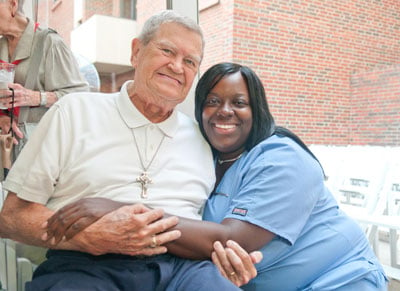At ERH, we believe in taking a holistic approach to living well.
Our wellness experts cultivate six dimensions of wellness that create a caring, integrative environment where residents find that life’s third act is the best one yet.
While we do believe that physical fitness is an important aspect of living well as we get older, it is by no means the only aspect of senior health. Emotional, spiritual, intellectual, vocational, and social health all contribute in their own way to mental wellness and general wellbeing.
And research is proving that such an approach to total wellness promotes happier and healthier senior living. Geriatric scientists are finding that psychological fitness is just as important as physical health when it comes to aging well.
"The word I like to describe successful aging is active aging," says Charles Reynolds III, a professor of geriatric psychiatry, neurology, and neuroscience at the University of Pittsburgh School of Medicine. "That means socially, intellectually, and spiritually."
Studies have shown that having meaningful and supportive relationships is an integral part of longevity and healthy senior living.
Companionship has played a role in helping some Americans see 100. Research shows that older adults who stay socially active—oftentimes volunteering for local nonprofits or helping raise grandchildren— have enjoyed happier, healthier, more purposeful lives beyond their hundredth birthday.

What Living Well Should Look Like
Though our senior living offers a wide range of leisure, social, and educational opportunities, both within the walls of our communities and out in the community of Greater Cincinnati, we don’t bombard newcomers with activity sign-up sheets.
Just as you can’t force exercise or healthy eating, genuine wellbeing and mental wellness must be initiated by the individual.
“Once the orientation process is completed,[I tell residents to] get settled in first,” says former Wellness Director and now Community Manager Victoria Pagan. “Get used to where you are right now and what you might like to do. We won’t go pounding on anyone’s door… We’re here when you’re ready.”
And it doesn’t take long.
As new residents start meeting their neighbors and making new connections, they start to join fitness classes and get involved in Bible studies, bridge tournaments, or computer tutoring. Almost before they know it, they’re joining theater groups, enjoying wine tastings with friends, and signing up to attend the Cincinnati Ballet, the Symphony, and the Opera.
The decline of social activity, then, seems to stem from lack of opportunity and not a desire for solitude—at least for older adults who have moved into our retirement communities. In fact, the social leisure and educational opportunities seem to be one of the major reasons why many older adults often move into senior living communities.
The Decline of Social Activity among Older Americans
Unfortunately, every passing year seems to bring increasing isolation for most seniors. According to the Federal Interagency Forum on Aging-Related Statistics, social activity tends to decline as American get older.
The majority of older adults spend their down time on activities that they can do at home:
- Americans over the age of 55 choose to park themselves in front of the television 58 percent of the time when they don’t have other obligations.
- Septuagenarians and their older compatriots will sometimes opt for quieter activities, spending about 12 percent of their free time with a good book and 9 percent of the time relaxing or spending time with their thoughts.
Fewer seniors opt to fill their time with exercise or social activities:
- Older adults spend no more than 5 percent of their time exercising or playing sports.
- Adults between the ages of 55 and 64 are slightly more socially active than their older compatriots, dedicating about 11 percent of leisure time to spending time with others.
- Socialization drops to 8 percent after age 75.
If you’re looking to keep living well as you get older, start looking for way you can be more active in your community. You can check out some of these posts on social networking for ideas to get yourself started.











